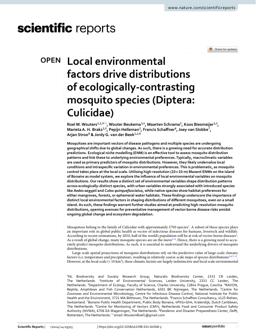2024-08-20
Local environmental factors drive distributions of ecologically‑contrasting mosquito species (Diptera: Culicidae)
Publication
Publication
Nature Scientific Reports , Volume 14 - Issue 19315
Mosquitoes are important vectors of disease pathogens and multiple species are undergoing geographical shifts due to global changes. As such, there is a growing need for accurate distribution predictions. Ecological niche modelling (ENM) is an effective tool to assess mosquito distribution patterns and link these to underlying environmental preferences. Typically, macroclimatic variables are used as primary predictors of mosquito distributions. However, they likely undervalue local conditions and intraspecific variation in environmental preferences. This is problematic, as mosquito control takes place at the local scale. Utilising high-resolution (10 × 10 m) Maxent ENMs on the island of Bonaire as model system, we explore the influence of local environmental variables on mosquito distributions. Our results show a distinct set of environmental variables shape distribution patterns across ecologically-distinct species, with urban variables strongly associated with introduced species like Aedes aegypti and Culex quinquefasciatus, while native species show habitat preferences for either mangroves, forests, or ephemeral water habitats. These findings underscore the importance of distinct local environmental factors in shaping distributions of different mosquitoes, even on a small island. As such, these findings warrant further studies aimed at predicting high-resolution mosquito distributions, opening avenues for preventative management of vector-borne disease risks amidst ongoing global change and ecosystem degradation.
| Additional Metadata | |
|---|---|
| , , , , , | |
| doi.org/10.1038/s41598-024-64948-y | |
| Nature Scientific Reports | |
| Released under the CC-BY 4.0 ("Attribution 4.0 International") License | |
| Organisation | Staff publications |
|
Roel M. Wouters, Beukema, W., Maarten Schrama, Biesmeijer, K., Marieta A. H. Braks, Pepijn Helleman, … van der Beek, J. (2024). Local environmental factors drive distributions of ecologically‑contrasting mosquito species (Diptera: Culicidae). Nature Scientific Reports, 14(19315). doi:10.1038/s41598-024-64948-y |
|
